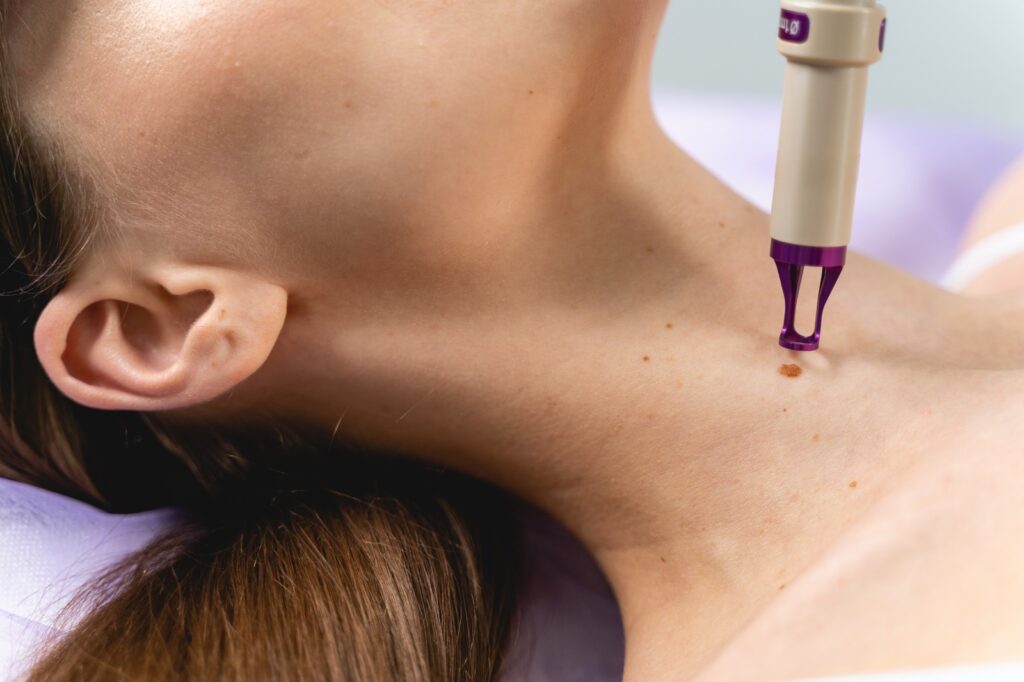Mole Removal Treatment in Islamabad
Mole removal is a medical or cosmetic procedure designed to eliminate a mole, which is a common skin growth that can appear on any part of the body. Moles are usually benign, but their removal may be recommended for several reasons, including concerns about their appearance, changes in size, shape, or color, or if there are any indications of potential malignancy.
Consultation
The process typically begins with a consultation with a dermatologist or healthcare provider who will assess the mole’s characteristics and determine if removal is necessary. They will also discuss the patient’s reasons for wanting the mole removed.
Methods of Removal
Various methods can be used to remove moles, and the choice of method depends on factors like the mole’s size, characteristics, and the need for a biopsy. Here’s an elaboration of different methods of mole removal

Excision
This method is commonly used for larger moles or those that are suspected of being cancerous. It typically involves the following steps:
The area is numbed with a local anesthetic to ensure the patient’s comfort during the procedure.
A scalpel is used to cut out the entire mole, including a margin of healthy skin around it. This is important, especially for potentially cancerous moles, to ensure that all abnormal cells are removed.
Stitches are often required to close the wound. The type of stitches used may vary, and some may need to be removed later, while others may dissolve on their own.
The excised tissue is usually sent for a biopsy to determine if there are any malignant cells present.
Shave Excision
Smaller, raised moles can be removed using shave excision. This method is less invasive and quicker than excision:
The mole is numbed with a local anesthetic.
A scalpel or a similar instrument is used to shave off the mole at the skin’s surface. This leaves the mole’s base intact, and it usually doesn’t require stitches.
Shave excision is suitable for non-cancerous moles that are raised above the skin’s surface. However, it may not be recommended for moles that are deeper or have suspicious characteristics.
Laser Removal
Laser technology can be used to remove smaller, non-cancerous moles. This method is less invasive and typically involves the following steps:
A specialized laser, which emits a high-energy light beam, is used to target and break down the pigment in the mole.
As the pigment is broken down, the mole fades gradually.
Laser removal is a relatively quick procedure and is often chosen for cosmetic reasons. However, it may not be suitable for all types of moles, especially larger or deeply pigmented ones.
Cryotherapy
Cryotherapy involves freezing the mole using liquid nitrogen or a similar freezing agent:
The freezing agent is applied to the mole, causing the tissue to freeze and subsequently die.
Over time, the frozen tissue will slough off, and the mole will gradually fall off or fade.
Cryotherapy is typically used for smaller, non-cancerous moles and is less invasive than surgical methods.
Electrocautery
Electrocautery uses an electrical current to burn off the mole:
An electrode is used to apply an electrical current to the mole, effectively burning the tissue.
Electrocautery is often chosen for smaller moles and is similar to cryotherapy in that it is less invasive and can be a quicker procedure.

It’s important to note that mole removal should be performed by a qualified medical professional, typically a dermatologist or a surgeon. The choice of removal method depends on the specific characteristics of the mole and the individual’s preferences. If there are concerns about the mole’s potential malignancy, a biopsy is often recommended to rule out skin cancer. The healthcare provider will provide guidance on post-removal care and any necessary follow-up.
Healing and Aftercare
After the mole is removed, the healing process begins. The specific aftercare instructions will depend on the removal method used. It’s essential to keep the area clean, follow any provided wound care instructions, and protect it from sun exposure.
Biopsy
In cases where there is a concern about the mole being cancerous, the removed tissue may be sent for a biopsy. This is to determine if there are any malignant cells present, and it helps guide further treatment if necessary.
Scarring
Mole removal may leave a scar, the size and appearance of which can vary depending on factors like the mole’s size, location, and the method of removal. Some methods, such as shave excision, are less likely to result in noticeable scarring.
Cosmetic Considerations
For those seeking mole removal for cosmetic reasons, it’s crucial to discuss expectations with the healthcare provider. In some cases, mole removal may not completely eliminate the appearance of the mole, and the individual may need to address any residual discoloration or scarring through additional cosmetic procedures.
Mole removal should be performed by a qualified medical professional, such as a dermatologist, to ensure it is done safely and effectively. It’s essential to follow their recommendations and be aware of any potential risks or complications associated with the procedure. If you notice changes in a mole’s appearance, such as irregular borders, color changes, or rapid growth, it is advisable to consult a healthcare provider promptly for a professional evaluation.
Consultation with a Professional
If you’re interested in scheduling a consultation, we encourage you to reach out by sending a message through the contact details provided via WhatsApp or by giving us a call. We’re here to assist you in setting up an appointment, answering any questions you may have, and ensuring a smooth and convenient booking process.
Your well-being and satisfaction are our top priorities, and we look forward to assisting you every step of the way.


